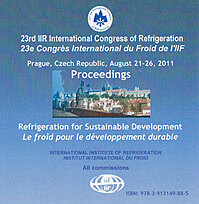
Résumé
In China, the production of perishable foods has reached 10 000 000 000 tonnes annually. Due to the low performance of refrigerated transport equipment and improper operation, 15 to 30% of perishable foods go rotten, costing €10 000 000 000 p.a. Infiltration can change the temperature and humidity of a refrigerated container (reefer) affecting food quality and transportation energy. Transport velocity is generally not considered a factor in food quality, except in allowing reduced transport time. The effect of transport velocity on infiltration was investigated using a refrigerated transport simulation testbed. The aim was to quantify the effect of leakage into the reefer at varied transport speeds to determine the level of infiltration occurring. A relationship between infiltration and transport speed was found to be approximately a positive linear relationship. Because different reefers will have different leakage characteristics new coefficients will need to be derived for each reefer. However, this relationship is always likely to approximate to a straight line with a positive slope.
Documents disponibles
Format PDF
Pages : 7 p.
Disponible
Prix public
20 €
Prix membre*
Gratuit
* meilleur tarif applicable selon le type d'adhésion (voir le détail des avantages des adhésions individuelles et collectives)
Détails
- Titre original : Dynamic performance of infiltration from a refrigerated container.
- Identifiant de la fiche : 30001984
- Langues : Anglais
- Source : Proceedings of the 23rd IIR International Congress of Refrigeration: Prague, Czech Republic, August 21-26, 2011. Overarching theme: Refrigeration for Sustainable Development.
- Date d'édition : 21/08/2011
Liens
Voir d'autres communications du même compte rendu (569)
Voir le compte rendu de la conférence
Indexation
-
Moyens spéciaux pour la livraison des denrées p...
- Auteurs : GRYZUNOV A. A.
- Date : 06/12/2004
- Langues : Russe
- Source : Refrigeration industry in the 21st century + CD-ROM.
Voir la fiche
-
Drain holes in reefer containers and the confli...
- Auteurs : LUKASSE L. J. S., PAILLART M. J. M.
- Date : 02/04/2013
- Langues : Anglais
- Source : 2nd IIR International Conference on Sustainability and the Cold Chain. Proceedings: Paris, France, April 2-4, 2013.
- Formats : PDF
Voir la fiche
-
Sensitivity analysis using CFD of air distribut...
- Auteurs : FINN D. P., BRENNAN S. L.
- Date : 17/08/2003
- Langues : Anglais
- Source : 21st IIR International Congress of Refrigeration: Serving the Needs of Mankind.
- Formats : PDF
Voir la fiche
-
Testing the validity of scale modelling theory ...
- Auteurs : ALAKA A., LOVE R., GRAY-STUART E., OLATUNJI J. R., EAST A. R.
- Date : 11/04/2022
- Langues : Anglais
- Source : 7th IIR International Conference on Sustainability and the Cold Chain (Online). Proceedings: April 11-13 2022
- Formats : PDF
Voir la fiche
-
Supercooling phenomena of eutectic slabs used i...
- Auteurs : STIENNE D., RAMEZ A., GUILPART J., et al.
- Date : 21/08/2011
- Langues : Anglais
- Source : Proceedings of the 23rd IIR International Congress of Refrigeration: Prague, Czech Republic, August 21-26, 2011. Overarching theme: Refrigeration for Sustainable Development.
- Formats : PDF
Voir la fiche
